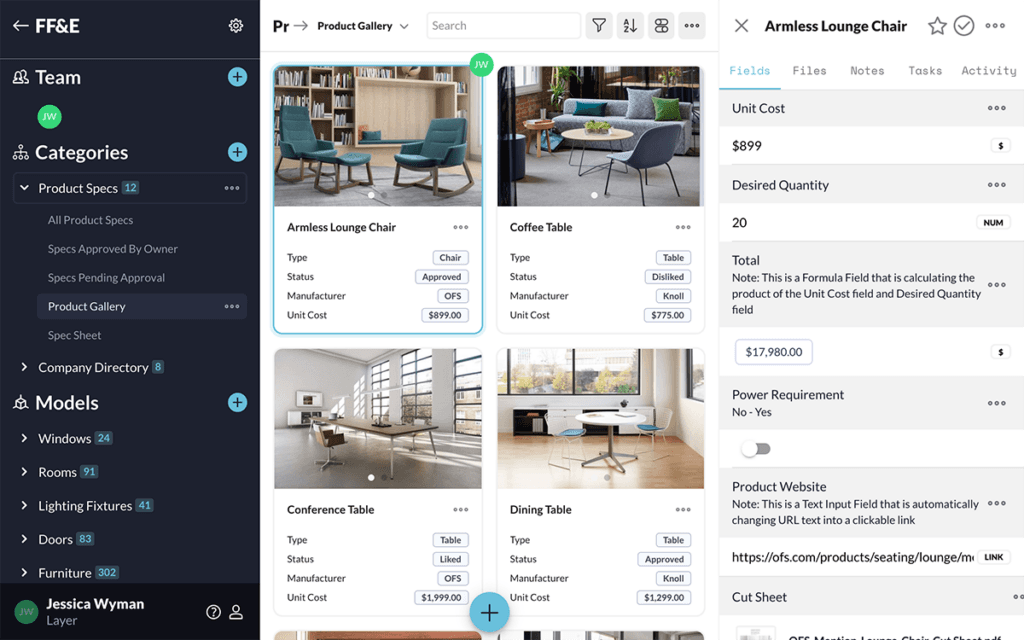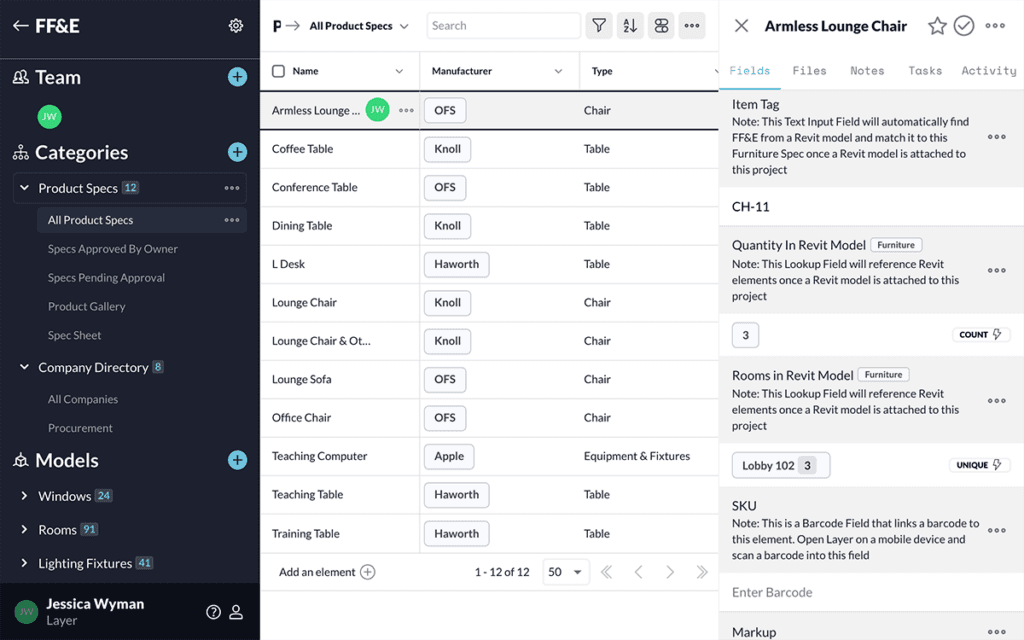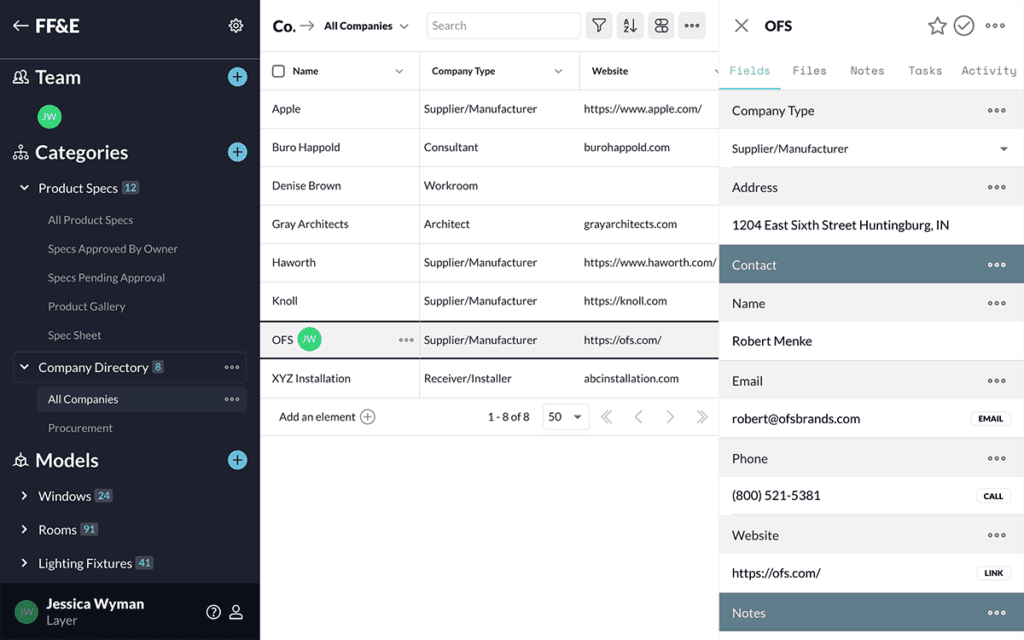Jessica Wyman
Updated: Dec 27, 2023
FF&E Procurement Explained
Learn the ins and outs of the FF&E Procurement process.
What is FF&E Procurement? We’ve explained what FF&E is, now what’s this about procurement?
Procurement is one of the biggest parts of the FF&E process. Typically, FF&E Procurement kicks off after construction has begun. The term ‘procurement’ in the design industry can be misleading. This process is often more involved than just obtaining the items that are specified.
Effective procurement is more than just placing an order. A well crafted procurement strategy includes budgeting, sourcing alternates and substitutes, and coordinating the installation and handover of everything that has been purchased and installed.
Who is in charge of FF&E Procurement?
Take, for example, a hospitality project. Hotel projects are unique because you have such a variety of spaces. At minimum, a hotel will have many bedrooms, a restaurant grade kitchen, a dining area, a lobby, and back-of-house spaces.
Typically you will have more vendors for more types of spaces. The office chairs for the HR office will likely be from a different source than bed frames destined for life in a hotel room. With so many vendors and pieces of data to track, many hospitality projects will hire an FF&E procurement company.
What is a Procurement Agent?
A procurement agency, or purchasing agent, will manage all discussions with vendors. They’ll also act as quality control for any delivered products. In doing this, they take a lot of work off the owner or designer. The designer can focus on the design and the agent can focus on logistics.
The designer (or possibly the owner) may manage procurement in-house for smaller scale projects. Hotel and restaurant chains or design agencies that roll out a lot of large scale projects most often have their own in-house teams. This often includes interior design & procurement staff working closely together.
FF&E Procurement in 3 Phases

The FF&E procurement process is comprised of three distinct phases: sourcing, purchasing, and follow through.
We'll walk through the FF&E procurement process from the perspective of a designer working with procurement agent on a large project.
1. Sourcing
First, the procurement agent will need to source the products. As the designer, you may have supplied exact specs, Procurement Drawings (PCDs) or design intent drawings for custom work. It is the procurement agent’s responsibility to execute this design intent for the best price and on schedule. A good procurement agent will find the balance between quality, schedule, and price.
Budget
Procurement typically starts when the project is under construction and the budget is set. You've probably already selected or designed FF&E pieces with a specific cost in mind.
The procurement agent will work to get the final number within that budget, including any freight costs. Additionally, it’s helpful to have fresh eyes on the budget, so you can easily spot areas of overspending.
A good procurement agent will have their finger on the pulse of current pricing and be dynamic in their problem-solving ability. Then the agent can keep these numbers up-to-date throughout the procurement process, through final delivery.

Alternates
Moreover, the procurer will help find alternates. Alternates might be necessary due to budget, lead times, or quality concerns, with approval from the designer or owner. Because of this, the procurement agent must have a discerning sense of quality. They should understand what the client is expecting quality-wise, and where there is room for compromise. They’ll also have expertise within their network of suppliers given their past projects.
Advantages to using a flexible database tool
Budget Reports: The designer can use a flexible database tool to manage FF&E costs. These numbers are updated instantly in the database as changes are made in the model and FF&E schedule. The designer can also export and share reports with non-Revit users, like the procurement agent.
Spec Sharing: Anyone with access to the flexible database tool can upload spec sheets, photos, or cost information right into the project.
Alternates: If alternates are necessary, you can create an 'approval status' field for each piece of FF&E in the database. Then, everyone can keep tabs on the approval status of the alternates.
2. Purchasing
The owner approved the budget and confirmed all alternates. Now you get to buy the product. For custom FF&E, the procurement agent may bid the design out to many manufacturers.
For off-the-shelf products, there may be multiple options for suppliers. Somebody who does a lot of procurement can use their relationship with suppliers to leverage a negotiation and ensure you’re getting the best quality for price.
Next, the procurement agent will submit purchase orders on your behalf. They will handle all necessary accounting with the accounting department or the owner directly. The agent will keep the client up to date on the status of the project as a whole. These updates report items purchased, dollars spent, and where the budget stands.
For custom work, designers and contractors will often need shop drawings. These may flow through the procurement agent so that they can check quantities and be the first set of eyes for quality control.
Advantages to using a flexible database tool
Status Updates: The procurement agent can use the flexible database tool to update purchase status, shop drawing status, and shipping status. The GC, owner, and designer can access the database to see status at any time.
Quantities: Even if the design has slightly changed since procurement kick-off, the procurement agent can pull the quantities from the flexible database tool, knowing that the information is up to date.
Shop Drawings: Once all necessary parties have approved shop drawings, you can file them into the flexible database tool so that everyone can reference them, even from within the model.

3. Follow Through
Potentially the most important task for procurement is 'follow through'. There’s a lot of product and owner’s property moving around and the procurement agent will ensure that it arrives to site safely and as expected.
Logistics
If the site is an active construction site, you don’t want new furniture that arrived early to be sitting there getting dusty and knocked around. The procurement agent can instruct vendors to ship any early FF&E items to a nearby warehouse. They can also update you on the current location when FF&E is delivered. Additionally, they can inspect on delivery to ensure it matches the shop drawing and arrived undamaged.
Installation
The site is ready. The FF&E can now be installed. For some pieces, this may just mean setting it down in the place it was designed. For something like a light fixture, multiple trades will have to coordinate site installation.
The procurement agent checks that everything was installed according to plan and ensures that It Is all ready for handover to the client. They act as a representative of the client, working in the client's best interest to ensure that they’re getting the quality they’ve paid for.
Handover
Then, once everything is installed according to plan, a lot of information needs to be passed on to the owner. This is called ‘handover’. The owner needs records of any purchase orders, an inventory of products that may be left in storage, installation and operation manuals, and manufacturer warranties.
Tools for FF&E Procurement
Regardless of who is procuring, how you manage all of the information related to FF&E is critical. Clear communication between the procurement, designer, and owner keeps the project on budget. There is a lot of data to manage, including cost, status, source, operation and installation instructions, and alternates in case something is not available.

To keep everyone on the same page, we recommend using a no-code workflow tool like Layer. A digital tool like this pulls information from your design model and can be viewed by whoever the procurement agent might be—whether they’re in-house or not. A flexible database tool will also make it possible to organize and view Revit data, FF&E specs, and vendor directory in one place.
Advantages to using a flexible database tool
Inspection: A mobile-friendly database tool makes it easy to document product conditions. The procurement agent creates fields to upload site photos or comments. These fields link directly to the product and vendor directory. It is also easy to create reports without leaving the tool.
Location Tracking: With lots of moving pieces of FF&E needed on site at different times, it’s important to keep track of where in the world each item is. With a flexible database tool that has barcode capabilities, it's easy scan and track if the FF&E item is on site, in the warehouse, or in transit.
Owner's Manual: The procurement agent or designer can store and organize all FF&E handover information in the flexible database tool, which they can easily transfer to the owner at closeout.

Conclusion
By now, you probably understand that procurement is fickle work. Whoever in charge of procurement must be a jack of all trades and very organized and detail oriented. To eliminate information oversight, we choose to use a flexible database tool to maintain a single line of communication. Putting an end to old-fashioned single-owner spreadsheets will reduce errors due to lack of communication and outdated data.




